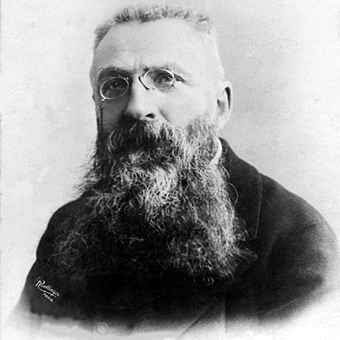 home
about
artists
exhibitions
press
contact
purchase
home
about
artists
exhibitions
press
contact
purchase |
|
AUGUSTE RODIN Biography
“Nothing is a waste of time if you use the experience wisely.” — Auguste Rodin
Synopsis
Early Life Due to poor vision, Rodin was greatly distressed at a young age. Attending the Petite École, he was unable to see figures drawn on the blackboard and, subsequently, struggled to follow complicated lessons written on the blackboard, usually in his math and science courses. Unaware of his imperfect eyesight, a dejected Rodin found comfort in drawing pictures—an activity that allowed Rodin to see his progress as he practiced, as well as clearly see the drawing paper in front of him (he was nearsighted). Soon, Rodin was drawing frequently, wherever he could, and whatever he saw or imagined. By age 13, Rodin had developed obvious skills as an artist, and soon began taking formal art courses. While completing his studies, however, the aspiring young artist began to doubt himself, receiving little validation or encouragement from his instructors and fellow students. Four years later, at age 17, Rodin applied to attend the École des Beaux-Arts, a prestigious art school in Paris. He was gravely disappointed when the school denied him admission, and deeply saddened when his application was rejected twice thereafter. Dejected and desperate to earn a living, in the late 1850s, Rodin began working as a decorative bricklayer.
Famous Sculptures Rodin soon completed his first piece, "The Vanquished" (later renamed "The Age of Bronze"), a sculpture of a nude man clenching his both of his fists, with his right hand hanging over his head. A depiction of suffering amidst hope for the future, the work was first exhibited in 1878, when Rodin was in his late 30s. While "The Age of Bronze" earned Rodin some recognition as a sculptor, he remained a relative unknown until a few years later, in the early 1880s—when Rodin, in his early 40s, first established both his distinct artistic style and a credible list of works. Rodin went on to create several other famous works, including "The Burghers of Calais," a public monument made of bronze portraying a moment during the Hundred Years' War between France and England, in 1347. The piece, which includes six human statues, depicts a war account that Rodin had researched, during which six French citizens from the town of Calais were ordered by King Edward III of England to abandon Calais and surrender themselves—barefoot and bareheaded, wearing ropes around their necks and holding the keys to the town and the caste in their hands—to the king, who ordered their execution thereafter. "The Burghers of Calais" is a portrayal of the moment that the citizens exited Calais. Rodin began working on the monument in 1884, after being commissioned by the town of Calais to create it. However, the piece wasn't unveiled in the town until more than a decade later, in 1895. After being commissioned to create an entrance piece for a planned museum (which was never built) in 1880, Rodin began working on "The Gates of Hell," an intricate monument of various sculpted figures, including "The Thinker" (1880) and "The Kiss" (1886). Although "The Gates of Hell" was commissioned for completion by 1884, the project proved to be more time-consuming than anyone had originally anticipated; several decades after its projected due date, Rodin was still working on the piece.
Death and Legacy Garnering acclaim for more than a century, Rodin is widely regarded as the pioneer of modern sculpture. His work continues to be studied and deeply admired by fellow artists, experts, scholars and art connoisseurs, as well as those with an untrained eye. |
